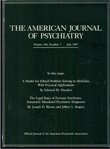Ventricular enlargement in schizophrenia: relationship to positive and negative symptoms
Abstract
The authors explored the clinical correlates of ventricular enlargement in schizophrenia by comparing 16 patients with "large" ventricles (ventricles more than I SD above the control mean) with 16 patients with the smallest ventricles from a sample of 52 schizophrenic patients. Patients with ventricular enlargement showed some impairment in the sensorium and had a preponderance of "negative" symptoms (e.g., alogia, affective flattening, avolition, anhedonia), while those with small ventricles were characterized by "positive" symptoms (e.g., delusions, hallucinations, positive formal thought disorder, bizarre behavior). These findings suggest that combining a measure of brain structure with the clinical picture may provide a useful new approach to the classification of schizophrenia.
Access content
To read the fulltext, please use one of the options below to sign in or purchase access.- Personal login
- Institutional Login
- Sign in via OpenAthens
- Register for access
-
Please login/register if you wish to pair your device and check access availability.
Not a subscriber?
PsychiatryOnline subscription options offer access to the DSM-5 library, books, journals, CME, and patient resources. This all-in-one virtual library provides psychiatrists and mental health professionals with key resources for diagnosis, treatment, research, and professional development.
Need more help? PsychiatryOnline Customer Service may be reached by emailing [email protected] or by calling 800-368-5777 (in the U.S.) or 703-907-7322 (outside the U.S.).



